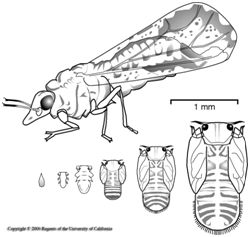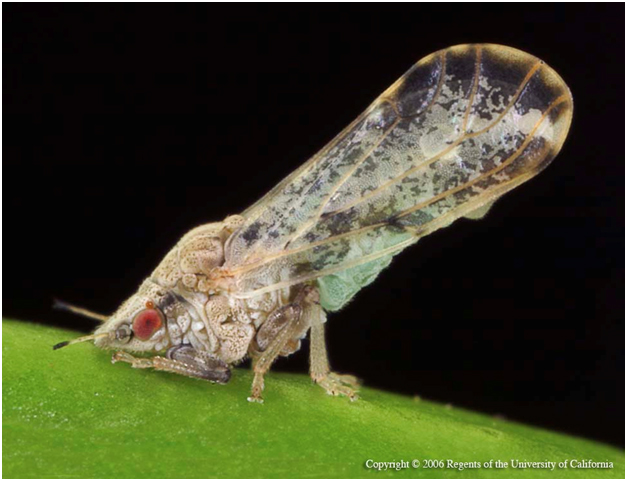Spring 2011 Field Observations
New serious pest found in Ventura County: Asian citrus psyllid
by Julie Newman
The California Department of Food and Agriculture announced that two Asian citrus psyllid (ACP) specimens were found in traps in commercial citrus orchards near La Conchita and Santa Paula in Ventura County last December. The finds triggered establishment of a quarantine zone encompassing all of Ventura County and part of southern Santa Barbara County. Host nursery stock plants cannot be moved out of the quarantine area, and all citrus fruit must be cleaned of leaves and stems prior to moving out of the quarantine area. The most common or preferred hosts of ACP are in the genera Citropis, Citrus and Murraya. Detection of a single ACP triggers eradication treatment of all host plants within 400 meters of an ACP find with cyfluthrin and imidacloprid.
The Asian citrus psyllid, Diaphorina citri (Kuwayama), feeds on host leaves and stems. Although the psyllid can damage plants, the real danger lies in its ability to transmit a phloem-inhabiting bacterium that causes a devastating disease called Huanglongbing (HLB). The disease is incurable, untreatable and fatal to all varieties of citrus. Diseased trees produce bitter, inedible, misshapen fruit and eventually die. HLB has destroyed citrus production in various parts of the world, including Florida, where the industry is now in rapid decline. Prompt eradication of new infestations is necessary to prevent ACP from becoming established in California.
ACP arrived in Southern California in 2008. Quarantines have been established in the following counties (listed in chronological order): San Diego, Imperial, Orange, Los Angeles, San Bernardino, Riverside and Ventura counties. So far, testing has not found any trapped insects or trees in California to be infected with HLB. ACP can spread throughout the state on infested host plants. Distribution of orange jasmine plants (Murraya paniculata) by retail nurseries was the main method of movement of ACP throughout Florida. ACP has also been intercepted coming into California in packages of fruits, plants, and on cut foliage shipped from other states and countries.
There are three life stages of the psyllid: eggs, nymphs and adults (fig.1). Eggs are bright yellow-orange, almond-shaped, and found on the tips of growing shoots or between unfurling leaves. Nymphs are yellowish-orange and feed exclusively on new growth. They move in a slow, steady manner and flick their abdomens when disturbed. Nymphs pass through five instars, and the later instars have large wing pads. The feeding nymphs produce long, waxy filaments that direct honeydew away from their bodies. The adults are 0.1 to 0.2 inches in length and are brown mottled. They feed with their heads down and their bodies lifted up at about a 45-degree angle to the plant surface (fig. 2). Adults jump or fly short distances when disturbed. Female adults lay about 300 to 800 eggs during their lifetime, which may last for more than a month. The total life cycle is from 15 to 47 days depending on environmental factors; there are typically 9 to 10 generations per year.

Fig. 1. Asian citrus psyllid life cycle. The insect progresses from egg (lower left) through 5 nymphal instars to the adult (above). Source: ANR Publication 8205. Illustration by G. O. Conville after Catling 1970.

Fig. 2. Asian citrus psyllid adult feeding. Source: ANR Publication 8205. Photo by M.E. Rogers.
Nursery growers in Southern California should visually inspect citrus plants and related ornamentals such as orange jasmine. Adults can be detected through visual surveys and yellow sticky cards. Monitoring for immature stages should be directed to the new growth, using a hand lens. Look for characteristic damage symptoms. High populations of psyllids can cause permanent deformation of newly formed leaves and shoots. The tender young growth becomes twisted and stunted. Honeydew produced by nymphs and adults allows growth of sooty mold that coats leaves. Ants, attracted by the honeydew, may be observed visiting infested plants.
If you suspect that you have found ACP, place the infested plant in a container or place adults and nymphs in alcohol. Contact your local county agricultural commissioner’s office for identification.
For more information, see ANR Publication 8205 http://anrcatalog.ucdavis.edu/Citrus/8205.aspx, the CDFA Asian citrus website: http://www.cdfa.ca.gov/phpps/acp/, and the Ventura County ACP-HLB Task Force on Facebook: http://www.facebook.com/pages/Ventura-County-ACP-HLB-Task-Force/351010182791?ref=mf.












